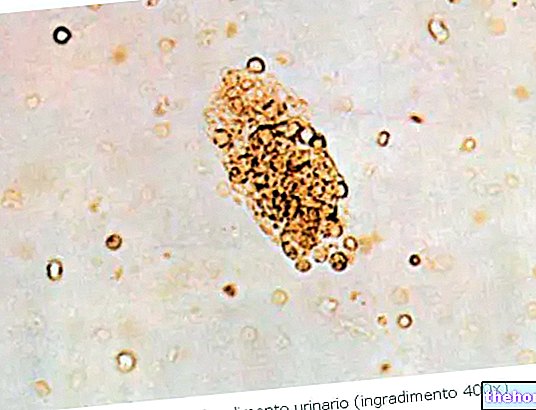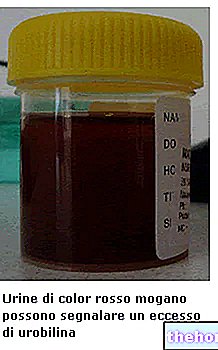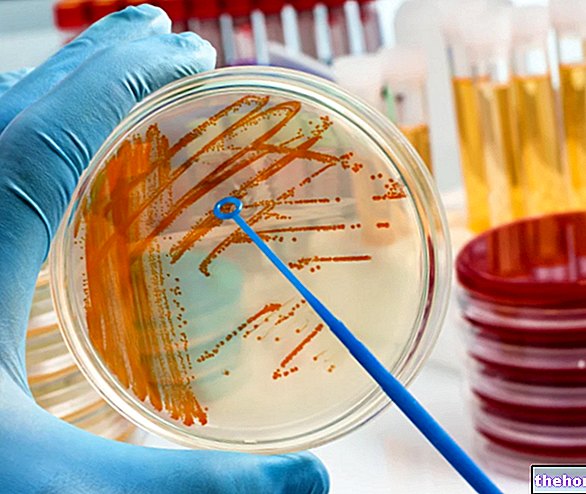Generality
Glomerulonephritis is an inflammatory disease that affects the kidneys, in particular the renal glomeruli, compromising their filtering capacity. Due to the inflammatory process that affects the kidneys, the meshes of the kidney sieves widen, and the glomeruli let out blood components that are normally retained: this is the case of proteins and red blood cells, which in the presence of glomerulonephritis are found in excessive quantities in the urine.
This loss impoverishes the blood of important components for the balance of body fluids, with the possible appearance of edema, anemia and hypertension.

Representation of a renal corpuscle: it is formed by a vascular portion (consisting of a ball of arterial capillaries called the renal glomerulus) enclosed by an epithelial capsule (Bowman's capsule).
The latter is composed of two epithelial sheets: the parietal sheet and the visceral one; the latter is composed of particular cells called podocytes.
A chamber called the glomerural chamber is created between the two epithelial sheets, inside which the renal filtrate pours.
The podocytes are equipped with extensions (the pedicels), with which they reach the capillary epithelium. These cells are negatively charged and have small gaps that prevent the passage of the larger molecules present in the blood. When damaged by an inflammatory process, the podocytes they increase their permeability, allowing even large molecules such as proteins to pass through.
The inflammatory process associated with glomerulonephritis is generally symmetrical and bilateral, thus involving the glomeruli of both kidneys.
There are numerous forms of glomerulonephritis, with different pathogenesis, course and prognosis, ranging from asymptomatic forms to lethal forms which evolve in an acute or chronic way towards renal insufficiency. The element that acts as a glue between the various forms is the presence of a inflammatory damage of the renal glomeruli, for the rest there is a "wide variability both for the causes of origin" and for the most adequate treatment.
We distinguish first of all acute and chronic forms, and primitive and secondary forms.
- Acute glomerulonephritis: sudden onset of haematuria and proteinuria, accompanied by rapidly progressive renal failure, with edema, hypertension, and increase in serum creatinine and azotemia
- Chronic glomerulonephritis: slow and progressive reduction of renal function, with urinary finding of hematuria and proteinuria, which slowly leads to uremic syndrome; the appearance of renal insufficiency takes days or years and is the consequence of wear damage to the surviving nephrons due to functional compensatory overload. Proteinuria, generally present, does not exceed 3 g in 24 hours
- Primary glomerulonephritis: affects only or mainly the kidney: the problem, the cause responsible for the disorder, therefore lies in the kidney
- Secondary glomerulonephritis: is the expression of pathologies affecting other organs or the whole organism (systemic diseases such as systemic lupus erythematosus or diabetes)
Sometimes glomerulonephritis cannot be traced back to a precise cause, since doctors are unable to identify the triggering etiopathological element: in this case we speak of idiopathic glomerulonephritis.
Renal glomerulus and kidney functions
The nephron is the functional unit of the kidney, that is, the smallest anatomical formation capable of carrying out all the functions that the organ is responsible for. Each of the approximately two thousand days of nephrons present in each kidney is divided into two essential components:
- renal or Malpinghi corpuscle (glomerulus + Bowman's capsule): responsible for filtration;
- tubular system: responsible for reabsorption and secretion;
and carries out three fundamental processes:
- filtration: occurs in the glomerulus, a highly specialized capillary system that allows all the small molecules of the blood to pass, opposing only the passage of larger proteins and blood cells;
- reabsorption and secretion: they occur in the tubular system, with the aim of recovering excessively filtered substances (eg glucose, which the body cannot afford to lose in the urine) and eliminating those that are insufficiently filtered.
Symptoms and complications
See also: Nephritis Symptoms
The main clinical manifestations of glomerulonephritis are: hematuria, proteinuria, impaired renal function, arterial hypertension, edema.
Clinically, it is important to distinguish:
- Glomerulonephritis associated with nephritic syndrome: characterized by proteinuria, hematuria associated with blood cylinders, arterial hypertension, edema due to sodium and water retention, normal or reduced renal function; is caused by "increased glomerular permeability and inflammatory damage to the glomerular capillaries
- Glomerulonephritis associated with nephrotic syndrome: characterized by proteinuria without hematuria, by hypoalbuminemia and edema, by hyperlipidimia and lipiduria; it is a less serious condition than the previous one, since there is an increase in glomerular permeability with preservation of renal functions, without passing red blood cells in the urine
Read more: How do symptoms of glomerulonephritis arise?
Inflammation and glomerular damage
↓
Serious alterations of permeability
↓
Proteinuria = significant loss of protein with urine → foam in urine may be noted
↓
Hypoproteinemia (or hypoprotidemia or hypoalbuminemia) = reduction of proteins in the blood (especially albumin, the most abundant plasma protein)
↓
Reduction of oncotic (or colloidosmotic) plasma pressure + lipiduria due to hyperlipidemia caused by the stimulus on the synthesis of lipoproteins in the liver and by the urinary loss of some factors that regulate lipid metabolism
↓
Fluid movement in the extracellular spaces → Appearance of edema (initially in the morning at the periorbital level, then extended to the feet, ankles and abdomen) + Hypovolemia + Reduction in blood pressure
↓
Reduction of blood flow to the kidney
↓
Increased renin secretion → Activation of the renin-angiotensin system + Increased release of aldosterone → Hydrosaline retention and worsening of edema + Mild hypertension → Increased hydrostatic pressure in the glomerulus, increased filtration process → wear of the nephrons due to functional overload
Glomerular damage with rupture of the endothelial layer of the glomerular capillaries
↓
Serious alterations of permeability
↓
Hematuria = presence of blood in the urine → in case of macrohematuria the urine takes on a dark color, similar to tea or coca-cola; in the case of microhematuria, the presence of blood in the urine can only be seen in the chemical-enzymatic examination of the urine
↓
Anemia = reduction in the concentration of red blood cells and hemoglobin in the blood, can also result from urinary loss of ferritin due to increased glomerular permeability (it is therefore also found in the case of glomerulonephritis associated with nephrotic syndrome)
↓
Weakness, fatigue
Inflammatory damage to the renal glomeruli, with infiltration of white blood cells and obstruction of the capillaries, leads to a reduction in the glomerular filtration rate
↓
Increased release of renin from the juxtraglomerular system with activation of the renin-angiotensin-aldosterone system
↓
Increased water and sodium retention, also due to the reduced excretory capacity of the kidney (especially sodium)
↓
Hypertension.
↓
Increase in the hydrostatic pressure of the blood, which together with the reduction of oncotic pressure favors the appearance of edema
Renal damage resulting from glumerolonephritis (release of proteolytic enzymes and inflammatory cytokines, formation of fibrin deposits) can also increase the presence of waste products in the circulation, due to loss of the filtering capacity of the nephron → clinically it can be associated with azotemia and hypercreatininemia → trend towards evolution towards renal insufficiency
Continued: Glomerulonephritis: Causes and Therapy "




























